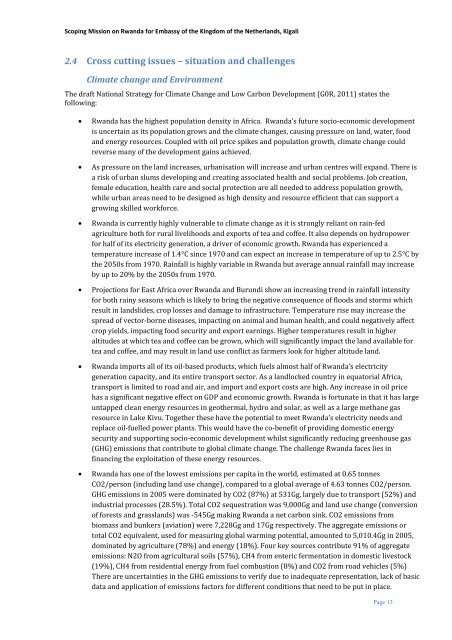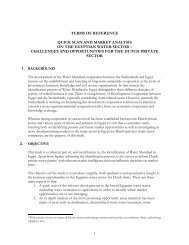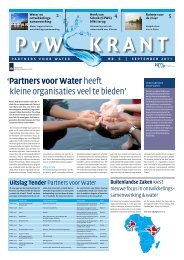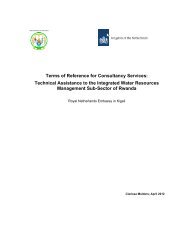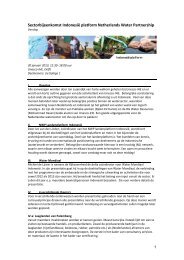Scoping mission on water in rwanda - Partners voor Water
Scoping mission on water in rwanda - Partners voor Water
Scoping mission on water in rwanda - Partners voor Water
Create successful ePaper yourself
Turn your PDF publications into a flip-book with our unique Google optimized e-Paper software.
<str<strong>on</strong>g>Scop<strong>in</strong>g</str<strong>on</strong>g> Missi<strong>on</strong> <strong>on</strong> Rwanda for Embassy of the K<strong>in</strong>gdom of the Netherlands, Kigali<br />
2.4 Cross cutt<strong>in</strong>g issues – situati<strong>on</strong> and challenges<br />
Climate change and Envir<strong>on</strong>ment<br />
The draft Nati<strong>on</strong>al Strategy for Climate Change and Low Carb<strong>on</strong> Development (G0R, 2011) states the<br />
follow<strong>in</strong>g:<br />
• Rwanda has the highest populati<strong>on</strong> density <strong>in</strong> Africa. Rwanda’s future socio-ec<strong>on</strong>omic development<br />
is uncerta<strong>in</strong> as its populati<strong>on</strong> grows and the climate changes, caus<strong>in</strong>g pressure <strong>on</strong> land, <strong>water</strong>, food<br />
and energy resources. Coupled with oil price spikes and populati<strong>on</strong> growth, climate change could<br />
reverse many of the development ga<strong>in</strong>s achieved.<br />
• As pressure <strong>on</strong> the land <strong>in</strong>creases, urbanisati<strong>on</strong> will <strong>in</strong>crease and urban centres will expand. There is<br />
a risk of urban slums develop<strong>in</strong>g and creat<strong>in</strong>g associated health and social problems. Job creati<strong>on</strong>,<br />
female educati<strong>on</strong>, health care and social protecti<strong>on</strong> are all needed to address populati<strong>on</strong> growth,<br />
while urban areas need to be designed as high density and resource efficient that can support a<br />
grow<strong>in</strong>g skilled workforce.<br />
• Rwanda is currently highly vulnerable to climate change as it is str<strong>on</strong>gly reliant <strong>on</strong> ra<strong>in</strong>-fed<br />
agriculture both for rural livelihoods and exports of tea and coffee. It also depends <strong>on</strong> hydropower<br />
for half of its electricity generati<strong>on</strong>, a driver of ec<strong>on</strong>omic growth. Rwanda has experienced a<br />
temperature <strong>in</strong>crease of 1.4°C s<strong>in</strong>ce 1970 and can expect an <strong>in</strong>crease <strong>in</strong> temperature of up to 2.5°C by<br />
the 2050s from 1970. Ra<strong>in</strong>fall is highly variable <strong>in</strong> Rwanda but average annual ra<strong>in</strong>fall may <strong>in</strong>crease<br />
by up to 20% by the 2050s from 1970.<br />
• Projecti<strong>on</strong>s for East Africa over Rwanda and Burundi show an <strong>in</strong>creas<strong>in</strong>g trend <strong>in</strong> ra<strong>in</strong>fall <strong>in</strong>tensity<br />
for both ra<strong>in</strong>y seas<strong>on</strong>s which is likely to br<strong>in</strong>g the negative c<strong>on</strong>sequence of floods and storms which<br />
result <strong>in</strong> landslides, crop losses and damage to <strong>in</strong>frastructure. Temperature rise may <strong>in</strong>crease the<br />
spread of vector-borne diseases, impact<strong>in</strong>g <strong>on</strong> animal and human health, and could negatively affect<br />
crop yields, impact<strong>in</strong>g food security and export earn<strong>in</strong>gs. Higher temperatures result <strong>in</strong> higher<br />
altitudes at which tea and coffee can be grown, which will significantly impact the land available for<br />
tea and coffee, and may result <strong>in</strong> land use c<strong>on</strong>flict as farmers look for higher altitude land.<br />
• Rwanda imports all of its oil-based products, which fuels almost half of Rwanda’s electricity<br />
generati<strong>on</strong> capacity, and its entire transport sector. As a landlocked country <strong>in</strong> equatorial Africa,<br />
transport is limited to road and air, and import and export costs are high. Any <strong>in</strong>crease <strong>in</strong> oil price<br />
has a significant negative effect <strong>on</strong> GDP and ec<strong>on</strong>omic growth. Rwanda is fortunate <strong>in</strong> that it has large<br />
untapped clean energy resources <strong>in</strong> geothermal, hydro and solar, as well as a large methane gas<br />
resource <strong>in</strong> Lake Kivu. Together these have the potential to meet Rwanda’s electricity needs and<br />
replace oil-fuelled power plants. This would have the co-benefit of provid<strong>in</strong>g domestic energy<br />
security and support<strong>in</strong>g socio-ec<strong>on</strong>omic development whilst significantly reduc<strong>in</strong>g greenhouse gas<br />
(GHG) e<str<strong>on</strong>g>missi<strong>on</strong></str<strong>on</strong>g>s that c<strong>on</strong>tribute to global climate change. The challenge Rwanda faces lies <strong>in</strong><br />
f<strong>in</strong>anc<strong>in</strong>g the exploitati<strong>on</strong> of these energy resources.<br />
• Rwanda has <strong>on</strong>e of the lowest e<str<strong>on</strong>g>missi<strong>on</strong></str<strong>on</strong>g>s per capita <strong>in</strong> the world, estimated at 0.65 t<strong>on</strong>nes<br />
CO2/pers<strong>on</strong> (<strong>in</strong>clud<strong>in</strong>g land use change), compared to a global average of 4.63 t<strong>on</strong>nes CO2/pers<strong>on</strong>.<br />
GHG e<str<strong>on</strong>g>missi<strong>on</strong></str<strong>on</strong>g>s <strong>in</strong> 2005 were dom<strong>in</strong>ated by CO2 (87%) at 531Gg, largely due to transport (52%) and<br />
<strong>in</strong>dustrial processes (28.5%). Total CO2 sequestrati<strong>on</strong> was 9,000Gg and land use change (c<strong>on</strong>versi<strong>on</strong><br />
of forests and grasslands) was -545Gg mak<strong>in</strong>g Rwanda a net carb<strong>on</strong> s<strong>in</strong>k. CO2 e<str<strong>on</strong>g>missi<strong>on</strong></str<strong>on</strong>g>s from<br />
biomass and bunkers (aviati<strong>on</strong>) were 7,228Gg and 17Gg respectively. The aggregate e<str<strong>on</strong>g>missi<strong>on</strong></str<strong>on</strong>g>s or<br />
total CO2 equivalent, used for measur<strong>in</strong>g global warm<strong>in</strong>g potential, amounted to 5,010.4Gg <strong>in</strong> 2005,<br />
dom<strong>in</strong>ated by agriculture (78%) and energy (18%). Four key sources c<strong>on</strong>tribute 91% of aggregate<br />
e<str<strong>on</strong>g>missi<strong>on</strong></str<strong>on</strong>g>s: N2O from agricultural soils (57%), CH4 from enteric fermentati<strong>on</strong> <strong>in</strong> domestic livestock<br />
(19%), CH4 from residential energy from fuel combusti<strong>on</strong> (8%) and CO2 from road vehicles (5%)<br />
There are uncerta<strong>in</strong>ties <strong>in</strong> the GHG e<str<strong>on</strong>g>missi<strong>on</strong></str<strong>on</strong>g>s to verify due to <strong>in</strong>adequate representati<strong>on</strong>, lack of basic<br />
data and applicati<strong>on</strong> of e<str<strong>on</strong>g>missi<strong>on</strong></str<strong>on</strong>g>s factors for different c<strong>on</strong>diti<strong>on</strong>s that need to be put <strong>in</strong> place.<br />
Page 13


